1993 CHEVROLET CAMARO tire type
[x] Cancel search: tire typePage 156 of 358

Your Driving and the Road
The three types of skids correspond to
your Chevrolet’s three control systems. In
the braking skid your wheels aren’t
rolling. In the steering or cornering skid,
too much speed or steering in a curve
causes tires to slip and lose cornering
force. And
in the acceleration skid too
much throttle causes the driving wheels to
spin.
A cornering skid and an acceleration skid
are best handled by easing your foot off
the accelerator pedal. If your vehicle
starts to slide (as when you turn a corner
on a wet, snow- or ice-covered road),
ease your
foot off the accelerator pedal as
soon as you feel the vehicle start to slide.
Quickly steer the way
you want the vehicle to
go. If you
start steering quickly
enough, your vehicle will straighten out.
As it does, straighten the front wheels.
Of course, traction
is reduced when water,
snow, ice, gravel, or other material is on
the road. For safety, you’ll want to
slow
down and adjust your driving to these
conditions. It is important to slow down
on slippery surfaces because stopping
distance will be longer and vehicle control more limited. While
driving on a surface
with reduced
traction,
try your best to avoid sudden
steering, acceleration, or braking
(including engine braking by shifting to a
lower gear). Any sudden changes could
cause the tires to slide.
You may not
realize the surface is slippery until your
vehicle is skidding. Learn to recognize
warning clues
- such as enough
water, ice or packed snow on the road to
make
a “mirrored surface” - and slow
down when you have any doubt.
Remember:
Any anti-lock braking system
(ABS) helps avoid only the braking skid.
Steer the way you want to go.
ProCarManuals.com
Page 159 of 358
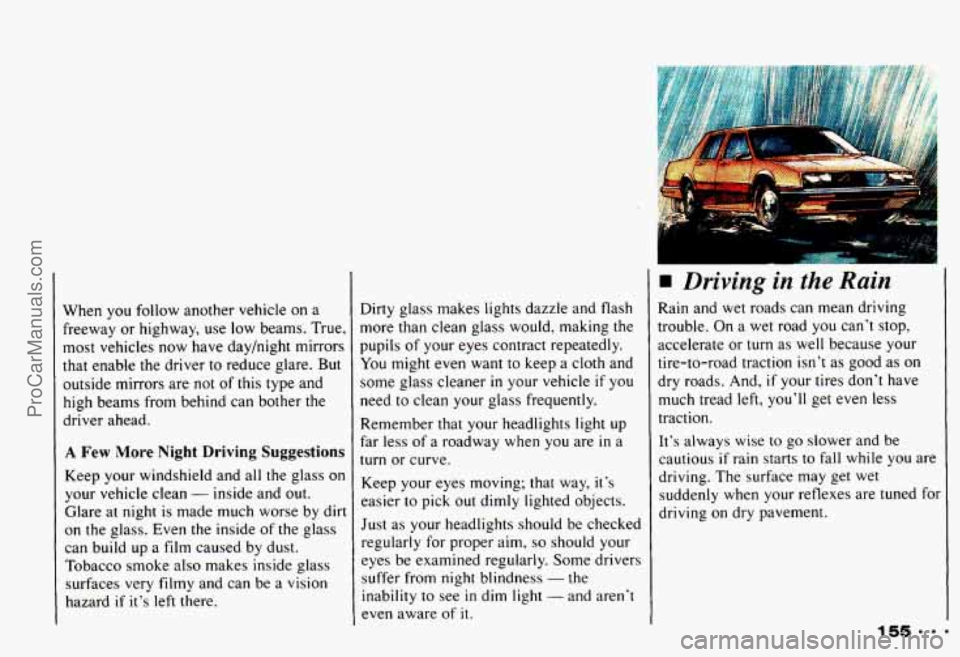
When you follow another vehicle on a
freeway or highway, use low beams. True,
most vehicles now have day/night mirrors
that enable the driver to reduce glare. But
outside mirrors are not of this type and
high beams from behind can bother the
driver ahead.
A Few More Night Driving Suggestions
Keep your windshield and all the glass on
your vehicle clean
- inside and out.
Glare at night is made much worse by dirt
on the glass. Even the inside of the glass
can build
up a film caused by dust.
Tobacco smoke also makes inside glass
surfaces very filmy and can be a vision
hazard
if it’s left there. Dirty
glass makes lights dazzle and flash
more than clean glass would, making the
pupils of your eyes contract repeatedly.
You might even want to keep a cloth and
some glass cleaner
in your vehicle if you
need to clean your glass frequently.
Remember that your headlights light
up
far less of a roadway when you are in a
turn or curve.
Keep your eyes moving; that
way, it’s
easier to pick
out dimly lighted objects.
Just as your headlights should be checked
regularly for proper aim,
so should your
eyes be examined regularly. Some drivers
suffer from
night blindness - the
inability to see
in dim light - and aren’t
even aware of
it.
Driving in the Rain
Rain and wet roads can mean driving
trouble. On a wet road you can’t stop,
accelerate or
turn as well because your
tire-to-road traction isn’t as good as on
dry roads. And,
if your tires don’t have
much tread left,
you’ll get even less
traction.
It’s always wise to go slower and be
cautious
if rain starts to fall while you are
driving. The surface may get wet
suddenly when your reflexes are tuned for
driving on
dry pavement.
ProCarManuals.com
Page 194 of 358
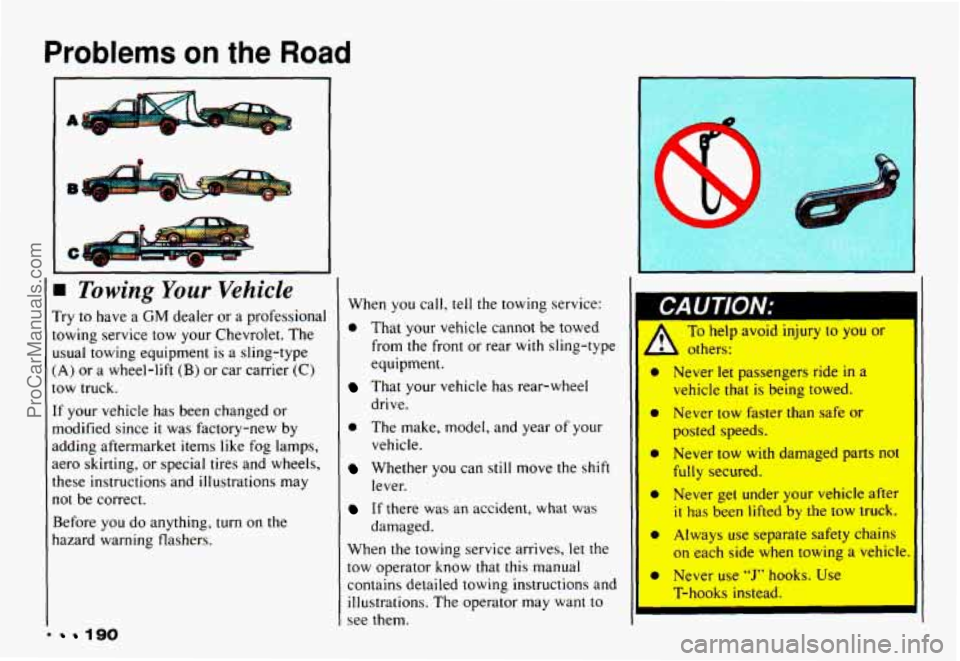
Problems on the Road
A
le
=Towing Your Vehicle
Try to have a CM dealer or a professional
towing service tow your Chevrolet. The
usual towing equipment is a sling-type
(A) or a wheel-lift (B) or car carrier (C)
tow truck.
If your vehicle has been changed or
modified since
it was factory-new by
adding aftermarket items like fog lamps,
aero skirting, or special tires and wheels,
these instructions and illustrations may
not be correct.
Before you do anything,
turn on the
hazard warning flashers.
190
When you call, tell the towing service:
0 That your vehicle cannot be towed
from the front or rear
with sling-type
equipment.
drive.
That your vehicle has rear-wheel
0 The make, model, and year of your
Whether you can still move the shift
If there was an accident, what was
When the towing service arrives, let the
tow operator know
that this manual
contains detailed towing instructions and
illustrations. The operator may want
to
see them.
vehicle.
lever.
damaged.
1
TO help avoid injury to you or
0
0
0
e
a
0
b others:
Never let passengers ride in a
vehicle that is being towed.
Never tow faster than safe
or
posted speeds.
Never
tow with damaged parts not
fully secured.
Never
get under your vehicle after
it has been lifted by the tow truck.
Always use separate safety chains
on each side when towing a vehicle,
Never use “J” hooks. Use
T-hooks instead.
ProCarManuals.com
Page 262 of 358
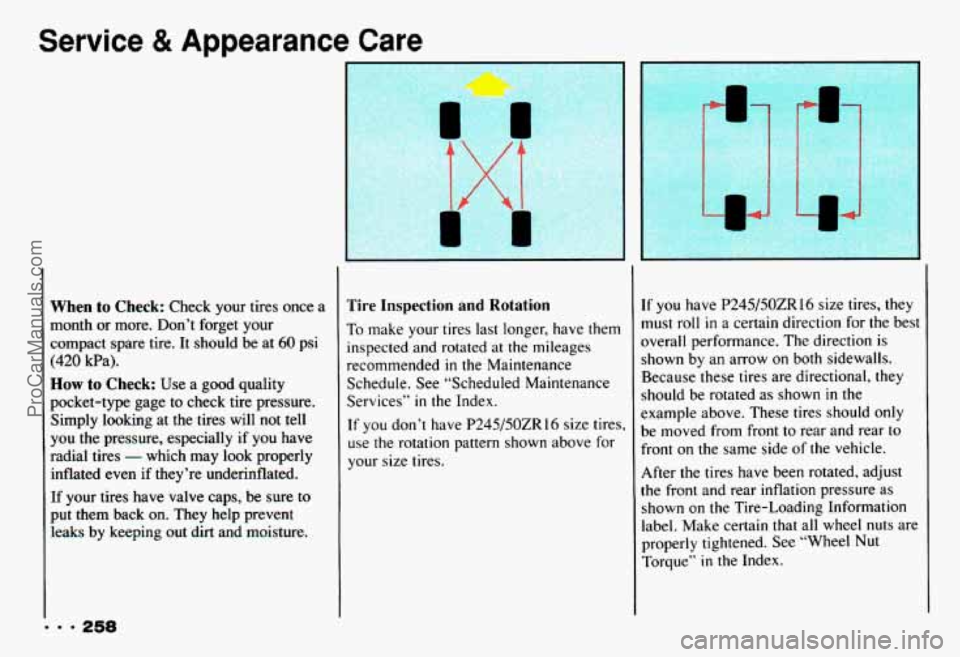
Service & Appearance Care
9 9 9 258
When to Check: Check your tires once a
month
or more. Don’t forget your
compact spare tire. It should be at
60 psi
(420 kPa).
How to Check: Use a good quality
pocket-type gage to check tire pressure.
Simply looking at the tires will not tell
you the pressure, especially if you have
radial tires
- which may look properly
inflated even if they’re underinflated.
If your tires have valve caps, be sure to
put them back on. They help prevent
leaks by keeping out
dirt and moisture.
L
’
Tire Inspection and Rotation
To make your tires last longer, have them
inspected and rotated at the mileages
recommended
in the Maintenance
Schedule. See “Scheduled Maintenance
Services”
in the Index.
If you don’t have
P245/50ZR 16 size tires,
use the rotation pattern shown above for
your size tires. If
you have P245/50ZR16 size tires, they
must roll
in a certain direction for the best
overall performance. The direction is
shown by an arrow on both sidewalls.
Because these tires are directional, they
should
be rotated as shown in the
example above. These tires should only
be moved from front to rear and rear to
front on the same side of the vehicle.
After the tires have been rotated, adjust
the front and rear inflation pressure as
shown on the Tire-Loading Information
label. Make certain that all wheel nuts are
properly tightened. See “Wheel
Nut
Torque” in the Index.
ProCarManuals.com
Page 264 of 358
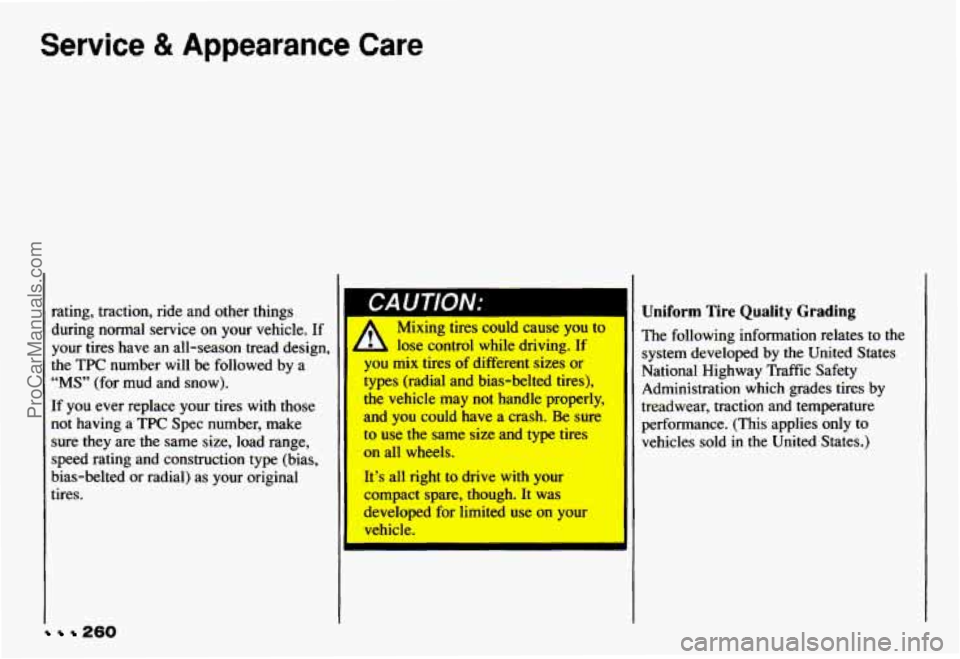
Service & Appearance Care
I
1
260
rating, traction, ride and other things during normal service on your vehicle. If
your tires have an all-season tread design,
&he
TPC number will be followed by a
“MS” (for mud and snow).
If you ever replace your tires with those
not having a TPC Spec number, make
sure they are the same size, load range, speed rating and construction type (bias,
bias-belted or radial) as your original
tires.
I bA u I /w/v.-
Mixing tires could cause you to
you mix tires of different sizes or
the vehicle may not handle properly,
and you could have a crash. Be sure
to use the same size and type tires
on all wheels,
It’s all right to drive with your
compact spare, though. It was
developed for limited use on your
vehicle.
typs
(radial ad bias-belted tires),
Uniform Tire Quality Grading
The following information relates to the
system developed
by the United States
National Highway Traffic Safety
Administration which grades tires by
treadwear, traction and temperature
performance.
(This applies only to
vehicles sold in the United States.)
ProCarManuals.com
Page 266 of 358

Service & Appearance Care
represent higher levels of performance on
the laboratory test wheel than the
minimum required by law.
Warning: The temperature grade for this
tire is established for a tire that is properly
inflated and not overloaded. Excessive
speed, underinflation, or excessive
loading, either separately or
in
combination, can cause heat buildup and
possible tire failure. Those grades
are molded on the sidewalls
of passenger car tires.
While the tires available as standard or
optional equipment on General Motors
vehicles may vary with respect to these
grades, all such tires meet General Motors
performance standards and have been
approved for use
on General Motors
vehicles.
All passenger type (P Metric)
tires must conform
to Federal safety
requirements
in addition to these grades.
Wheel Alignment and Tire Balance
The wheels on your vehicle were aligned
and balanced carefully at the factory to
give you the longest tire life and best
overall performance.
In most cases, you will not need to have
your wheels aligned again. However,
if
you notice unusual tire wear or your
vehicle pulling one way or the other, the
alignment may need to be reset.
If you
notice your vehicle vibrating when
driving on a smooth road, your wheels
may need to be rebalanced.
... 262
ProCarManuals.com
Page 268 of 358
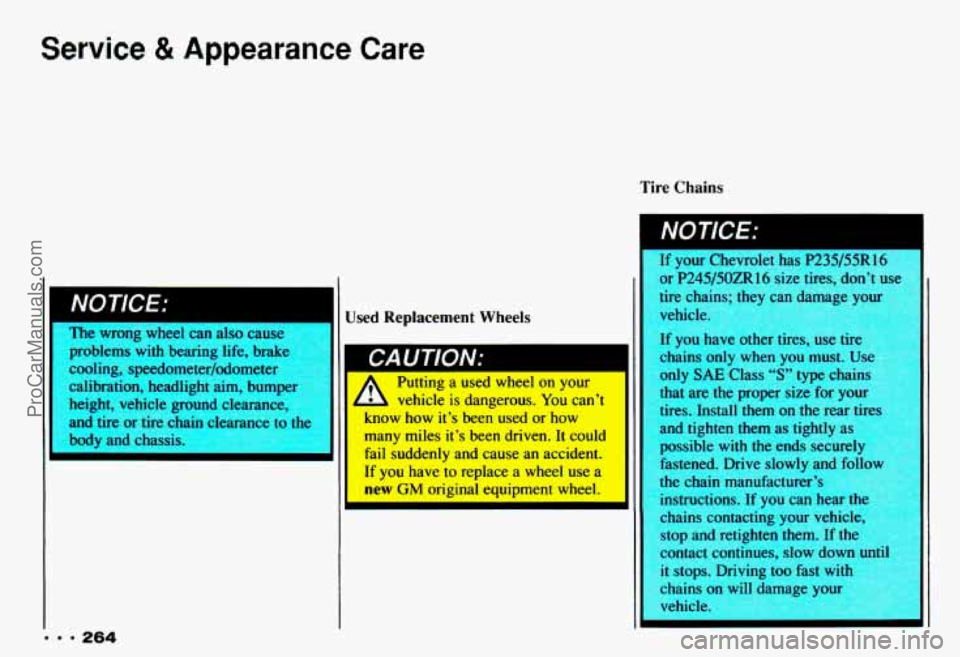
Service & Appearance Care
Tire Chains
IL
The wrong wheel can also cause
problems with bearing life, brake
cooling, speedometer/odometer
y!g@
calibration, headlight aim, bumper32
‘ i.i _. /8*
. .I )
height, vehicle ground clearance,
and tire or tire chain clearance to the
body and chassis. 1
... 264
Used Replacement Wheels
ruwllg it uscu WIIGGI UII yuul
vehicle is dangerous. You can’t
nnOW how it’s been used or how
many miles it’s been driven. It could
fail suddenly and cause an accident.
If you have to replace a wheel use a
new GM original equipment wheel.
Ib
If your Chevrolet has P235/55R16
or
P245/50ZRlf; cize tire. don’t 11c~ I
tire chains: the --In dm e vow I
I
vehicle.
If
you ,.-ve other tires, “st; LIIC
chains only when you must. Use
only
SAE Class “S” type chains
that are the proper size for
y
tires. Install them on the rear tires
and tighten them as tightly as
possible
with the ends securel)
fastened. Drive slowly and
folio
stop and retighten them. If the I
the chain manufacturer’s
instructions.
If you can hear th
chains contacting your vehicle
contact continues, slow down until
I
it stops. Driving too fast wit
chains on will damage yourg
vchicle.
I
ProCarManuals.com
Page 270 of 358
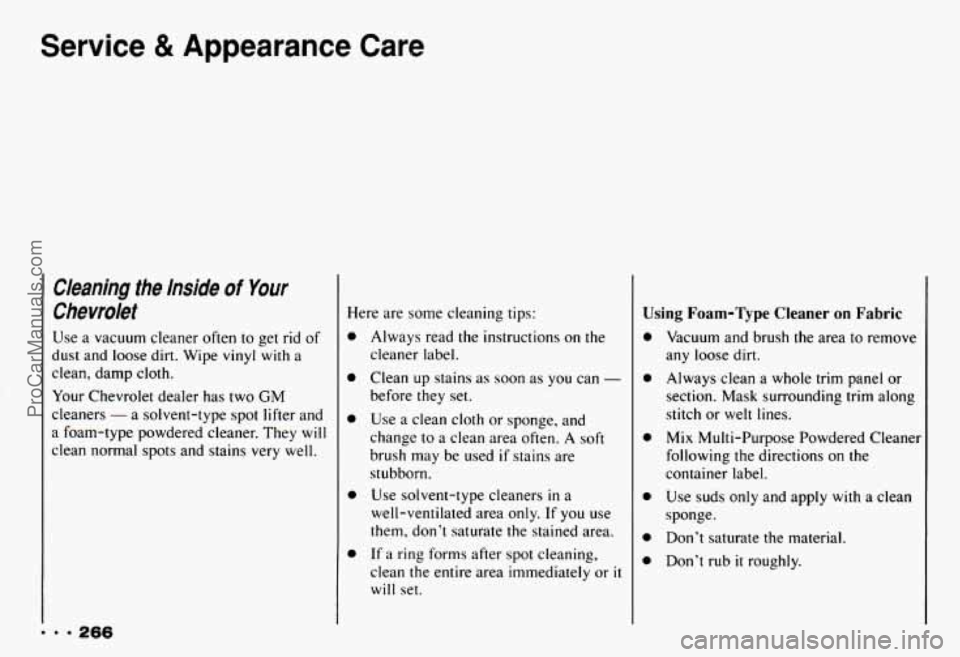
Service & Appearance Care
m.. 266
Cleaning the Inside of Your
Chevrolet
Use a vacuum cleaner often to get rid of
dust and loose dirt. Wipe
vinyl with a
clean, damp cloth.
Your Chevrolet dealer has two
GM
cleaners - a solvent-type spot lifter and
a foam-type powdered cleaner. They
will
clean normal spots and stains very well. Here are some cleaning tips:
0 Always read the instructions
on the
cleaner label.
Clean up stains
as soon as you can -
before they set.
Use a clean cloth or sponge, and
change to a clean area often.
A soft
brush
may be used if stains are
stubborn.
Use solvent-type cleaners
in a
well-ventilated area only. If you use
them, don’t saturate the stained area.
If
a ring forms after spot cleaning,
clean the entire area immediately or
it
will set.
Using Foam-Type Cleaner on Fabric
0
Vacuum and brush the area to remove
any loose
dirt.
Always clean a whole trim panel or
section. Mask surrounding trim along
stitch or welt lines.
Mix Multi-Purpose Powdered Cleaner
following the directions on the
container label.
Use suds only and apply
with a clean
sponge.
Don’t saturate the material.
Don’t rub
it roughly.
ProCarManuals.com